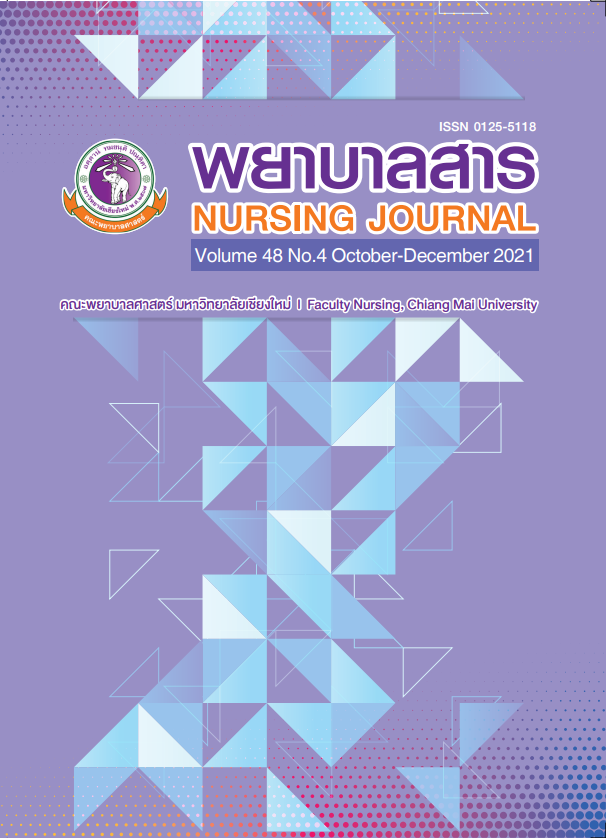Unhealthy Weight, Low Physical Activity, and Unhealthful Dietary Practices Among Chinese Gallstone Patients
Keywords:
prevalence, unhealthy weight, low physical activity, unhealthful dietary practices, Chinese gallstone patientsAbstract
A descriptive research design was used in this study to explore unhealthy weight, low physical activity, and unhealthful dietary practices among Chinese gallstone patients in Lincang City, Yunnan Province, the People’s Republic of China. Purposive sampling was used to recruit 324 participants from the People’s Hospital of Lincang and the Second People’s Hospital of Lincang from April, 2020 to June, 2020. Measurement tools included: 1) Demographic Data Record Form; 2) the Body Mass Index (BMI) record form; 3) International Physical Activity Questionnaire (IPAQ); and 4) Start The Conversation: Diet (STC). The translation and back translation method were used to ensure quality of the Chinese version. The test-retest reliability for the IPAQ and STC were 0.84 and 0.71, respectively. Descriptive statistics were used to describe the demographic characteristics, as well as the prevalence of unhealthy weight, low physical activity, and unhealthful dietary practices of the participants. Results of this study revealed that the prevalence of Chinese gallstone patients who had unhealthy weight, low physical activity level, and unhealthful dietary practices were 72.84%, 70.06% and 30.86%, respectively. Results from this study confirmed high prevalence of unhealthy weight, low physical activity, and unhealthful dietary practices among Chinese gallstone patients in Lincang City, Yunnan Province, the PRC. Gallstone risk screening and prevention measures can be made possible through these findings.
References
Ansari-Moghaddam, A., Khorram, A., Miri-Bonjar, M., Mohammadi, M., & Ansari, H. (2016). The prevalence and risk factors of gallstone among adults in South-East of Iran: A population-based study. Global Journal of Health Science, 8(4), 60.
Bilal, M., Haseeb, A., Saad, M., Ahsan, M., Raza, M., Ahmed, A., . . . Motiani, V. (2016). The prevalence and risk factors of gall stone among adults in Karachi, South Pakistan: A population-based study. Global Journal of Health Science, 9(4), 106-114.
Bonfrate, L., Wang, D. Q., Garruti, G., & Portincasa, P. (2014). Obesity and the risk and prognosis of gallstone disease and pancreatitis. Best Practice & Research Clinical Gastroenterology, 28(4), 623-635.
Chen, J. Y., Hsu, C. T., Liu, J. H., & Tung, T. H. (2014). Clinical predictors of incident gallstone disease in a Chinese population in Taipei, Taiwan. BMC Gastroenterology, 14(1), 83.
Chen, L. Y., Qiao, Q. H., Zhang, S. C., Chen, Y. H., Chao, G. Q., & Fang, L. Z. (2012). Metabolic syndrome and gallstone disease. World Journal of Gastroenterology: WJG, 18(31), 4215.
Huang, Y., Chen, P. P., & Feng, X. S. (2010). Changes in cholelithiasis types between 1970-1979 and 2000-2009. Journal of Abdominal Surgery, 4, 22.
Jones, C., Mawhinney, A., & Brown, R. (2012). The true cost of gallstone disease. The Ulster Medical Journal, 81(1), 10.
Macfarlane, D., Chan, A., & Cerin, E. (2011). Examining the validity and reliability of the Chinese version of the International Physical Activity Questionnaire, long form (IPAQ-LC). Public Health Nutrition, 14(3), 443-450.
Paxton, A. E., Strycker, L. A., Toobert, D. J., Ammerman, A. S., & Glasgow, R. E. (2011). Starting the conversation: Performance of a brief dietary assessment and intervention tool for health professionals. American Journal of Preventive Medicine, 40(1), 67-71.
Sachdeva, S., Khan, Z., Ansari, M. A., Khalique, N., & Anees, A. (2011). Lifestyle and gallstone disease: Scope for primary prevention. Indian Journal of Community Medicine: Official Publication of Indian Association of Preventive & Social Medicine, 36(4), 263.
Song, H., Thisse, J. F., & Zhu, X. (2012). Urbanization and/or rural industrialization in China. Regional Science and Urban Economics, 42(1-2), 126-134.
Sopajareeya, C., Sopajaree, S., Sopajaree, C., & Ibarra-Mejia, G. (2018). Prevalence and risk factors of low backpain among school teachers in Uttaradit and Phitsanulok Provinces. Nursing Journal, 45(2), 76-87.
Stokes, C. S., Krawczyk, M., & Lammert, F. (2011). Gallstones: Environment, lifestyle, and genes. Digestive Diseases, 29(2), 191-201.
Stringer, M. D., Fraser, S., Gordon, K. C., Sharples, K., & Windsor, J. A. (2013). Gallstones in New Zealand: Composition, risk factors and ethnic differences. ANZ Journal of Surgery, 83(7-8), 575-580.
Sun, Y. (2018). Analysis of dynamic body shape changes of rural population aged 20-59 in Lincang from 2000 to 2014. (Unpublished master's thesis). Yunnan Normal University, China.
Wadden, T. A., Webb, V. L., Moran, C. H., & Bailer, B. A. (2012). Lifestyle modification for obesity: New developments in diet, physical activity, and behavior therapy. Circulation, 125(9), 1157-1170.
Warttig, S., Ward, S., & Rogers, G. (2014). Diagnosis and management of gallstone disease: Summary of NICE guidance. BMJ, 349, g6241.
Xu, Q., Tao, L., Wu, Q., Gao, F., Zhang, F., Yuan, L., & He, X. (2012). Prevalences of and risk factors for biliary stones and gallbladder polyps in a large chinese population. HPB: The Official Journal of the International Hepato Pancreato Biliary Association, 14(6), 373-81. doi:10.1111/j.1477-2574. 2012.00457. x
Yamane, T. (1973). Statistics: An introductory analysis (3rd ed.). New York: Harper & Row.
Zahra, N., & Kaisrani, H. (2019). Link of obesity and gallstones formation risk. Advances in Obesity, Weight Management & Control, 9(5), 118-120.
Zhang, W. Z., He, F., Fu, L., & Deng, L. (2020). Analysis of dietary risk factors for gallstone occurrence. Journal of North Sichuan Medical College, 35(04), 126-129. (in Chinese)
Zhang, Q., Wang, Q. Q., Liu, Z. T., Li, J. J., Yu, S. Y., Zhao, J., . . . Wang, R. (2016). Nutrient intake and dietary structure analysis of urban and rural residents in Yunnan. China Public Health, 32(005), 661-663. (in Chinese).
Downloads
Published
How to Cite
Issue
Section
License
บทความที่ได้รับการตีพิมพ์เป็นลิขสิทธิ์ของวารสารพยาบาลสาร
ข้อความที่ปรากฏในบทความแต่ละเรื่องในวารสารวิชาการเล่มนี้เป็นความคิดเห็นส่วนตัวของผู้เขียนแต่ละท่านไม่เกี่ยวข้องกับมหาวิทยาลัยเชียงใหม่ และคณาจารย์ท่านอื่นๆในมหาวิทยาลัยฯ แต่อย่างใด ความรับผิดชอบองค์ประกอบทั้งหมดของบทความแต่ละเรื่องเป็นของผู้เขียนแต่ละท่าน หากมีความผิดพลาดใด ๆ ผู้เขียนแต่ละท่านจะรับผิดชอบบทความของตนเองแต่ผู้เดียว






